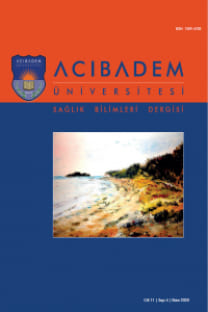KAZARA KAYBEDILEN TÜNELLI VENÖZ KATETERLERIN ESKI SUBKUTAN TRAKT YOLUYLA KURTARILMASI
The Salvage Treatment of Accidentally Lost Tunneled Venous Catheters Using Existing Subcutaneous Tracts
Tunneled catheter hemodialysis, central venous,
___
Salahi H, Fazelzadeh A, Mehdizadeh A, Razmkon A, Malek-Hosseini SA. Complications of arteriovenous fistula in dialysis patients. Transplant Proc 2006;38:1261–4. [CrossRef]Asquith JR. Dialysis Access Management. In: Cowling MG, editor. Vascular Interventional Radiology. Medical Radiology (Diagnostic Imaging). Berlin, Heidelberg: Springer; 2007. [CrossRef]
Aydin Z, Gursu M, Uzun S, Karadag S, Tatli E, Sumnu A, et al. Placement of Hemodialysis catheters with a technical, functional, and anatomical viewpoint. Int J Nephrol 2012;2012:302826. [CrossRef]
Gray RJ, Levitin A, Buck D, Brown LC, Sparling YH, Jablonski KA, et al. Percutaneous fibrin sheath stripping versus transcatheter urokinase infusion for malfunctioning well positioned tunneled central venous dialysis catheters: A prospective, randomized trial. J Vasc Interv Radiol 2000;11:1121–9. [CrossRef]
Lorenz JM. Unconventional venous access techniques. Semin Intervent Radiol 2006;23:279–86. [CrossRef]
Donati G, Coli L, Cianciolo G, La Manna G, Cuna V, Montanari M, et al. Thrombosis of tunneled-cuffed hemodialysis catheters: Treatment with high-dose urokinase lock therapy. Artif Organs 2012;36:21–8. [CrossRef]
Duszak R Jr, Haskal ZJ, Thomas-Hawkins C, Soulen MC, Baum RA, Shlansky-Goldberg RD, Cope C. Replacement of failing tunneled hemodialysis catheters through preexisting subcutaneous tunnels: a comparison of catheter function and infection rates for the novo placement and over-the-wire exchanges. J Vasc Interv Radiol 1998;9:321–7. [CrossRef]
Merport M, Murphy TP, Egglin TK, Dubel GJ. Fibrin sheath stripping versus catheter exchange for the treatment of failed tunneled hemodialysis catheters: randomized clinical trial. J Vasc Interv Radiol 2000;11:1115–20. [CrossRef]
Resic H, Ajanovic S, Kukavica N, Coric A, Masnic F, Beciragic A. Tunneled catheter infections in patients on hemodialysis--one center experience. Acta Med Croatica 2012;66:17–21. https://hrcak. srce.hr/99534
Izoard S, Ayzac L, Meynier J, Seghezzi JC, Jolibois B, Tolani ML. Infections on catheters in hemodialysis: Temporal fluctuations of the infectious risk Nephrol Ther 2017;13:463–9. [CrossRef]
- ISSN: 1309-470X
- Yayın Aralığı: 4
- Başlangıç: 2010
- Yayıncı: ACIBADEM MEHMET ALİ AYDINLAR ÜNİVERSİTESİ
Eser Elementler ile Diabetes Mellitus Komplikasyonları Arasındaki İlişki
Mustafa Çağrı SAYILIR, Bülent ERBİL, Mehmet Ali ASLANER, Mehmet Mahir ÖZMEN
Dışkapı Yıldırım Beyazıt Eğitim ve Araştırma Hastanesi, Acil Tıp, Ankara, Türkiye
Hanife Tiryaki ŞEN, Şehrinaz POLAT, Nihal Ünaldı BAYDIN, Ayda Uzunçarşılı SOYDAŞ
Erdem ERİŞ, Sinan BEKMEZ, İrfan PERENTE, Ali Rıza Cenk ÇELEBİ
Şant Kullanılmadan ve Primer Tamir ile Karotis Arter Endarterektomi Cerrahisi
Üniversite Öğrencilerinde Nomofobi ve Sosyal Anksiyete Düzeylerinin Karşılaştırılması
Ayşe GÜROL, Serap Ejder APAY, Süreyya ÖZDEMİR, Seval USLU, Ramazan GÜVEN
Hakkari İlinde Görülen Kanser Türlerinin ve Prevalanslarının Değerlendirilmesi
KAZARA KAYBEDILEN TÜNELLI VENÖZ KATETERLERIN ESKI SUBKUTAN TRAKT YOLUYLA KURTARILMASI
Nural Erzurum ALİM, Gözde Arıtıcı ÇOLAK, Rahime Evra KARAKAYA, Selin DÜNDAR
